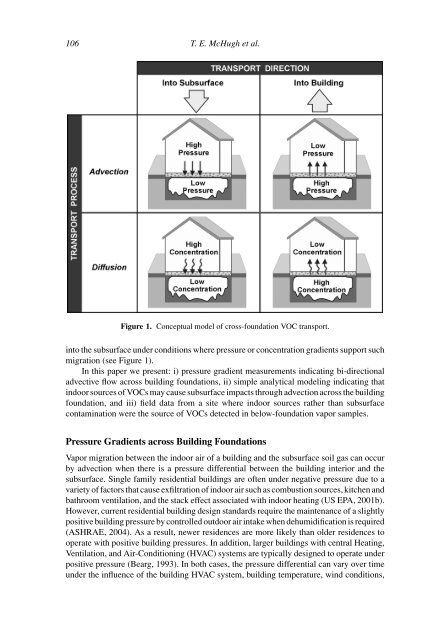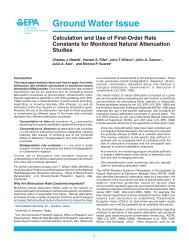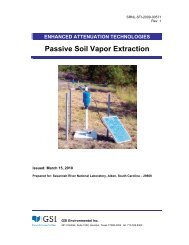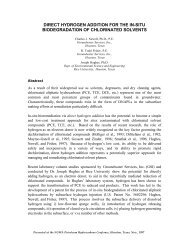Indoor Air as a Source of VOC Contamination in Shallow Soils - GSI ...
Indoor Air as a Source of VOC Contamination in Shallow Soils - GSI ...
Indoor Air as a Source of VOC Contamination in Shallow Soils - GSI ...
You also want an ePaper? Increase the reach of your titles
YUMPU automatically turns print PDFs into web optimized ePapers that Google loves.
106 T. E. McHugh et al.Figure 1. Conceptual model <strong>of</strong> cross-foundation <strong>VOC</strong> transport.<strong>in</strong>to the subsurface under conditions where pressure or concentration gradients support suchmigration (see Figure 1).In this paper we present: i) pressure gradient me<strong>as</strong>urements <strong>in</strong>dicat<strong>in</strong>g bi-directionaladvective flow across build<strong>in</strong>g foundations, ii) simple analytical model<strong>in</strong>g <strong>in</strong>dicat<strong>in</strong>g that<strong>in</strong>door sources <strong>of</strong> <strong>VOC</strong>s may cause subsurface impacts through advection across the build<strong>in</strong>gfoundation, and iii) field data from a site where <strong>in</strong>door sources rather than subsurfacecontam<strong>in</strong>ation were the source <strong>of</strong> <strong>VOC</strong>s detected <strong>in</strong> below-foundation vapor samples.Pressure Gradients across Build<strong>in</strong>g FoundationsVapor migration between the <strong>in</strong>door air <strong>of</strong> a build<strong>in</strong>g and the subsurface soil g<strong>as</strong> can occurby advection when there is a pressure differential between the build<strong>in</strong>g <strong>in</strong>terior and thesubsurface. S<strong>in</strong>gle family residential build<strong>in</strong>gs are <strong>of</strong>ten under negative pressure due to avariety <strong>of</strong> factors that cause exfiltration <strong>of</strong> <strong>in</strong>door air such <strong>as</strong> combustion sources, kitchen andbathroom ventilation, and the stack effect <strong>as</strong>sociated with <strong>in</strong>door heat<strong>in</strong>g (US EPA, 2001b).However, current residential build<strong>in</strong>g design standards require the ma<strong>in</strong>tenance <strong>of</strong> a slightlypositive build<strong>in</strong>g pressure by controlled outdoor air <strong>in</strong>take when dehumidification is required(ASHRAE, 2004). As a result, newer residences are more likely than older residences tooperate with positive build<strong>in</strong>g pressures. In addition, larger build<strong>in</strong>gs with central Heat<strong>in</strong>g,Ventilation, and <strong>Air</strong>-Condition<strong>in</strong>g (HVAC) systems are typically designed to operate underpositive pressure (Bearg, 1993). In both c<strong>as</strong>es, the pressure differential can vary over timeunder the <strong>in</strong>fluence <strong>of</strong> the build<strong>in</strong>g HVAC system, build<strong>in</strong>g temperature, w<strong>in</strong>d conditions,






